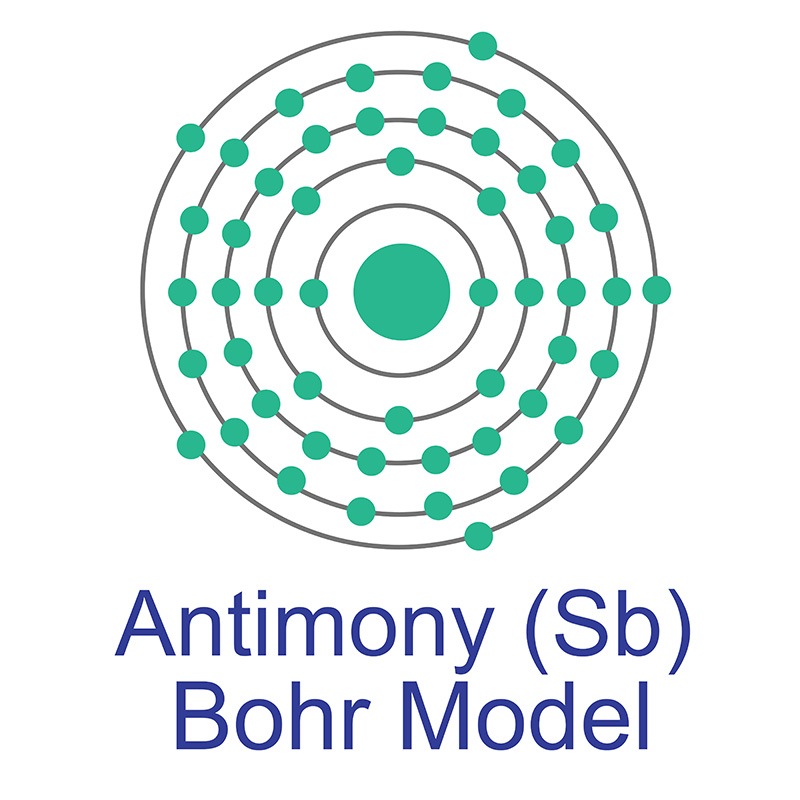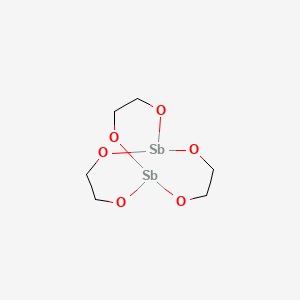SECTION 1. IDENTIFICATION
Product Name: Antimony Glycolate
Product Number: All applicable American Elements product codes, e.g. SB-GLYC-01
CAS #: 29736-75-2
Relevant identified uses of the substance: Scientific research and development
Supplier details:
American Elements
10884 Weyburn Ave.
Los Angeles, CA 90024
Tel: +1 310-208-0551
Fax: +1 310-208-0351
Emergency telephone number:
Domestic, North America: +1 800-424-9300
International: +1 703-527-3887
SECTION 2. HAZARDS IDENTIFICATION
Classification according to Regulation (EC) No. 1272/2008 [CLP]
Serious eye damage/eye irritation, Category 2 H319
Signal word (CLP) : Warning
Hazard statements (CLP) :
H319 - Causes serious eye irritation.
Precautionary statements (CLP) :
P280 - Wear protective gloves/protective clothing/eye protection/face protection.
P264 - Wash hands thoroughly after handling.
P305+P351+P338 - IF IN EYES: Rinse cautiously with water for several minutes. Remove contact lenses, if present and easy to do. Continue rinsing.
P337+P313 - If eye irritation persists: Get medical advice/attention
SECTION 3. COMPOSITION/INFORMATION ON INGREDIENTS
Substance type : Mono-constituent
Name : Poly(ANTIMONY ETHYLENE GLYCOXIDE)
CAS-No. : 29736-75-2
EC-No. : 249-820-2
SECTION 4. FIRST AID MEASURES
First-aid measures general:
Remove contaminated clothing and shoes. In case of accident or if you feel unwell, seek medical advice immediately (show the label where possible). If possible show this sheet; if not available show packaging or label.
First-aid measures after inhalation:
Remove person to fresh air and keep comfortable for breathing. If you feel unwell, seek medical advice.
First-aid measures after skin contact:
Wash with plenty of water/…. Get medical advice/attention.
First-aid measures after eye contact:
Immediately flush eyes thoroughly with water for at least 15 minutes. Remove contact lenses, if present and easy to do. Continue rinsing. Get medical advice/attention.
First-aid measures after ingestion:
Never give anything by mouth to an unconscious person. Get medical advice/attention.
Most important symptoms and effects, both acute and delayed
Symptoms/effects after inhalation:
May cause irritation to the respiratory tract.
Symptoms/effects after skin contact:
May cause skin irritation.
Symptoms/effects after eye contact:
Causes serious eye irritation.
Symptoms/effects after ingestion:
May be harmful if swallowed.
SECTION 5. FIREFIGHTING MEASURES
Suitable extinguishing media:
Foam. Carbon dioxide. Dry chemical.
Unsuitable extinguishing media : Avoid water spray as n-butanol will be generated.
Special hazards arising from the substance or mixture
Fire hazard:
Irritating fumes and organic acid vapors may develop when material is exposed to elevated temperatures or open flame.
Advice for firefighters
Firefighting instructions:
Exercise caution when fighting any chemical fire.
Protection during firefighting:
Do not enter fire area without proper protective equipment, including respiratory protection. Avoid contact with skin and eyes. Do not breathe dust.
SECTION 6. ACCIDENTAL RELEASE MEASURES
For non-emergency personnel
Protective equipment:
Wear protective equipment as described in Section 8.
Emergency procedures:
Evacuate unnecessary personnel.
For emergency responders
Protective equipment:
Do not attempt to take action without suitable protective equipment. Equip cleanup crew with proper protection. For further information refer to section 8: "Exposure controls/personal
protection".
Environmental precautions:
Notify authorities if product enters sewers or public waters. Prevent entry to sewers and public waters.
Methods and material for containment and cleaning up
For containment :
Contain any spills with dikes or absorbents to prevent migration and entry into sewers or
streams.
Methods for cleaning up:
Sweep or shovel spills into appropriate container for disposal.
SECTION 7. HANDLING AND STORAGE
Precautions for safe handling:
Avoid contact with skin and eyes. Do not breathe dust. Avoid dust formation. Do not allow dust to accumulate in work areas. Provide local exhaust or general room ventilation to minimize exposure to dust.
Hygiene measures:
Wash contaminated clothing before reuse. Wash hands and other exposed areas with mild soap and water before eating, drinking or smoking and when leaving work.
Conditions for safe storage, including any incompatibilities
Storage conditions:
Keep container tightly closed.
Incompatible materials:
Water.
Storage area:
Store in a well-ventilated place. Store away from heat.
SECTION 8. EXPOSURE CONTROLS/PERSONAL PROTECTION
Appropriate engineering controls:
Provide local exhaust or general room ventilation.
Personal protective equipment:
Avoid all unnecessary exposure. Emergency eye wash fountains and safety showers should be available in the immediate vicinity of any potential exposure.
Hand protection:
Neoprene or nitrile rubber gloves
Eye protection:
Chemical goggles. Contact lenses should not be worn
Skin and body protection:
Wear suitable protective clothing
Respiratory protection:
Where exposure through inhalation may occur from use, respiratory protection equipment is recommended. NIOSH-certified dust and mist (orange cartridge) respirator.
SECTION 9. PHYSICAL AND CHEMICAL PROPERTIES
Physical state : Solid
Appearance : Solid.
Molecular mass : 423.67 g/mol
Colour : White.
Odour : No data available
Odour threshold : No data available
Refractive index : No additional information available
pH : No data available
Relative evaporation rate (butylacetate=1) : No data available
Melting point : > 100 °C decomposes
Freezing point : No data available
Boiling point : No data available
Flash point : > 110 °C
Auto-ignition temperature : No data available
Decomposition temperature : No data available
Flammability (solid, gas) : No data available
Vapour pressure : No data available
Relative vapour density at 20 °C : No data available
Relative density : No data available
Solubility : Reacts with water.
Log Pow : No data available
Log Kow : No data available
Viscosity, kinematic : No data available
Viscosity, dynamic : No data available
Explosive properties : No data available
Oxidising properties : No data available
Explosive limits : No data available
SECTION 10. STABILITY AND REACTIVITY
Reactivity:
No additional information available
Chemical stability:
Stable.
Possibility of hazardous reactions:
Material decomposes slowly in contact with air by reaction with moisture, liberating n-butanol and antimony oxide.
Conditions to avoid:
Heat. Open flame. Sparks.
Incompatible materials:
Water.
Hazardous decomposition products:
Antimony oxide fumes. Organic acid vapors.
SECTION 11. TOXICOLOGICAL INFORMATION
Acute toxicity : Not classified
Skin corrosion/irritation : Not classified
Serious eye damage/irritation : Causes serious eye irritation.
Respiratory or skin sensitisation : Not classified
Germ cell mutagenicity : Not classified
Carcinogenicity : Not classified
Reproductive toxicity : Not classified
STOT-single exposure : Not classified
STOT-repeated exposure : Not classified
Aspiration hazard : Not classified
Symptoms/effects after inhalation : May cause irritation to the respiratory tract.
Symptoms/effects after skin contact : May cause skin irritation.
Symptoms/effects after eye contact : Causes serious eye irritation
Symptoms/effects after ingestion : May be harmful if swallowed.
Reason for classification : Expert judgment
SECTION 12. ECOLOGICAL INFORMATION
Toxicity
Acute aquatic toxicity : Not classified
Chronic aquatic toxicity : Not classified
Persistence and degradability
No additional information available
Bioaccumulative potential
No additional information available
Mobility in soil
No additional information available
Results of PBT and vPvB assessment
No additional information available
Other adverse effects
Other adverse effects : This substance may be hazardous to the environment
SECTION 13. DISPOSAL CONSIDERATIONS
Sewage disposal recommendations : Do not dispose of waste into sewer.
Product/Packaging disposal recommendations :
Dispose of solid materials or residues at a licensed site. Dispose in a safe manner in accordance with local/national regulations.
Ecology - waste materials : Avoid release to the environment.
SECTION 14. TRANSPORT INFORMATION
UN number
In accordance with ADR / RID / IMDG / IATA / ADN
UN number
UN-No. (ADR) : Not applicable
UN-No. (IMDG) : Not applicable
UN-No. (IATA) : Not applicable
UN-No. (ADN) : Not applicable
UN-No. (RID) : Not applicable
UN proper shipping name
Proper Shipping Name (ADR) : Not applicable
Proper Shipping Name (IMDG) : Not applicable
Proper Shipping Name (IATA) : Not applicable
Proper Shipping Name (ADN) : Not applicable
Proper Shipping Name (RID) : Not applicable
ADR
Transport hazard class(es) (ADR) : Not applicable
IMDG
Transport hazard class(es) (IMDG) : Not applicable
IATA
Transport hazard class(es) (IATA) : Not applicable
ADN
Transport hazard class(es) (ADN) : Not applicable
RID
Transport hazard class(es) (RID) : Not applicable
Packing group
Packing group (ADR) : Not applicable
Packing group (IMDG) : Not applicable
Packing group (IATA) : Not applicable
Packing group (ADN) : Not applicable
Packing group (RID) : Not applicable
Environmental hazards
Dangerous for the environment : No
Marine pollutant : No
Other information : No supplementary information available
Special precautions for user
- Overland transport
No data available
- Transport by sea
No data available
- Air transport
No data available
- Inland waterway transport
No data available
- Rail transport
No data available
Transport in bulk according to Annex II of Marpol and the IBC Code
Not applicable
SECTION 15. REGULATORY INFORMATION
EU-Regulations
No REACH Annex XVII restrictions
Poly(ANTIMONY ETHYLENE GLYCOXIDE) is not on the REACH Candidate List
Poly(ANTIMONY ETHYLENE GLYCOXIDE) is not on the REACH Annex XIV List
Poly(ANTIMONY ETHYLENE GLYCOXIDE) is not subject to REGULATION (EU) No 649/2012 OF THE EUROPEAN PARLIAMENT AND OF THE
COUNCIL of 4 July 2012 concerning the export and import of hazardous chemicals.
Poly(ANTIMONY ETHYLENE GLYCOXIDE) is not subject to Regulation (EC) No 850/2004 of the European Parliament and of the Council of 29
April 2004 on persistent organic pollutants and amending Directive 79/117/EEC
National regulations
Germany
12th Ordinance Implementing the Federal
Immission Control Act - 12.BImSchV
: Is not subject of the 12. BlmSchV (Hazardous Incident Ordinance)
Netherlands
SZW-lijst van kankerverwekkende stoffen : The substance is not listed
SZW-lijst van mutagene stoffen : The substance is not listed
NIET-limitatieve lijst van voor de voortplanting
giftige stoffen – Borstvoeding
: The substance is not listed
NIET-limitatieve lijst van voor de voortplanting
giftige stoffen – Vruchtbaarheid
: The substance is not listed
NIET-limitatieve lijst van voor de voortplanting
giftige stoffen – Ontwikkeling
SECTION 16. OTHER INFORMATION
Safety Data Sheet according to Regulation (EC) No. 1907/2006 (REACH). The above information is believed to be correct but does not purport to be all inclusive and shall be used only as a guide. The information in this document is based on the present state of our knowledge and is applicable to the product with regard to appropriate safety precautions. It does not represent any guarantee of the properties of the product. American Elements shall not be held liable for any damage resulting from handling or from contact with the above product. See reverse side of invoice or packing slip for additional terms and conditions of sale. COPYRIGHT 1997-2022 AMERICAN ELEMENTS. LICENSED GRANTED TO MAKE UNLIMITED PAPER COPIES FOR INTERNAL USE ONLY.

 The most common source of antimony is the
The most common source of antimony is the 
